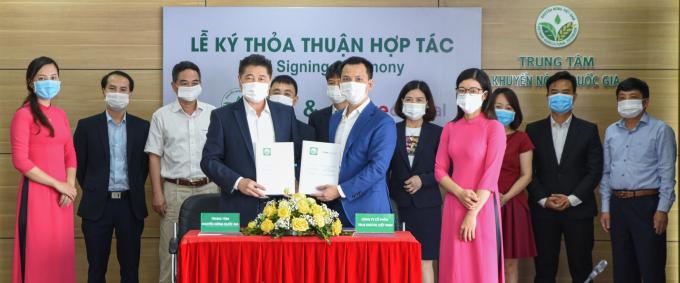May 29, 2025 | 05:53 GMT +7
May 29, 2025 | 05:53 GMT +7
Hotline: 0913.378.918
May 29, 2025 | 05:53 GMT +7
Hotline: 0913.378.918

The agreement signing ceremony to help farmers apply 4.0 technology in husbandry on the morning of July 22nd. Photo: Tung Dinh.
The National Agricultural Extension Center’s representative to the signing ceremony was Mr. Le Quoc Thanh, Director of the Center, on the other part, the True Digital Vietnam representative was Mr. Nguyen Manh Long, Director of the company's digital division.
According to Mr. Le Quoc Thanh, the National Agricultural Extension Center is currently the unit assigned by the Ministry of Agriculture and Rural Development to develop the application of new technologies in production with a new perspective that is to promote public-private cooperation, especially from international groups such as True Digital.
“In order to be able to take shortcuts and take the lead, we must rely on the most advanced technology. Therefore, the National Agricultural Extension Center is constantly looking for suitable partners to develop the application of technology in agricultural production through public-private partnership programs", said Mr. Le Quoc Thanh.
In the opinion of the Director of the National Agricultural Extension Center, PPP is the optimal method to make use of the socialization resources and technological potential of the private side as well as improve the operational efficiency of the nationwide agricultural extension system.
“With the cooperation agreement signed today, we think that the technology solutions that True Digital offers are very suitable for the development strategy of bringing high technology into production, especially at the farm and farming household level, directly to farmers”, shared the Director of the National Agricultural Extension Center.
To clarify more about his technology background, Mr. Nguyen Manh Long, Digital Director of True Digital elaborated that the company's main platform is in the agricultural sector.
“True Digital is gradually bringing its technology products into the agricultural production process in Vietnam. Along with that, the testing and verification stages are carried out regularly”, said Mr. Long, adding that the first two areas that True Digital wants to develop in Vietnam are dairy and broiler farming, expands more on shrimp, pig and cultivation in the future.
Particularly, regarding technology solutions for dairy farming, True Digital will apply technology to maximize the reproductive process of cows, control the health of each cow individual and control the herd through transceivers.
As for broilers, True Digital's technology will solve problems related to flock weight, control microclimate and disease in the barn, connect to the supply chains through a system of cameras and sensors mounted in the barn.
According to the True Digital representative, if advanced technologies can be applied to production, farmers can both save costs and improve the operational efficiency of their models. However, to make the best use of this effect, it is necessary to have the participation of the National Agricultural Extension Center.
/2025/05/25/4127-3-073637_820.jpg)
(VAN) Thanks to the promotion from an FAO-implemented project, vegetable production in greenhouses in Moc Chau has seen strong development, from 1.5 hectares in 2021 to nearly 50 hectares in 2024.

(VAN) FAO has recently supported USD 140,000 to implement the project 'Risk mitigation human-animal interface risks through disease control initiatives in pig farming.'

(VAN) The People's Committee of Tra Vinh province has approved an adjustment to the investment policy for the Green Hydrogen Plant project, increasing its area to approximately 52.76 hectares.
![Reducing emissions from rice fields: [2] Farmers’ commitment to the soil](https://t.ex-cdn.com/nongnghiepmoitruong.vn/608w/files/news/2025/05/05/dsc08881jpg-nongnghiep-140632.jpg)
(VAN) Clean rice cultivation model in Thuong Tan commune, Bac Tan Uyen district, is assisting local residents in achieving sustainable agriculture by substantially reducing costs, increasing productivity, and protecting the environment.

(VAN) At the conference to disseminate Resolution No. 68, AgriS introduced its digital agricultural ecosystem and reaffirmed its commitment to accompanying the Government in promoting private sector development and sustainable agriculture.

(VAN) 'Blue Ocean - Blue Foods' initiative is designed to restore marine ecosystems and establish sustainable livelihoods for local communities by cultivating a minimum of 1,000 hectares of cottonii seaweed in the first three years.
/2025/05/21/4642-3-112707_603.jpg)
(VAN) The V-SCOPE project has made direct contributions to three out of six pillars of the Comprehensive Strategic Partnership between Vietnam and Australia.